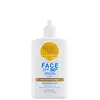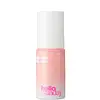What's inside
What's inside
 Key Ingredients
Key Ingredients

 Benefits
Benefits

 Concerns
Concerns

 Ingredients Side-by-side
Ingredients Side-by-side

Water
Skin ConditioningHomosalate
Skin ConditioningOctocrylene
UV AbsorberDibutyl Adipate
EmollientButyl Methoxydibenzoylmethane
UV AbsorberMethylene Bis-Benzotriazolyl Tetramethylbutylphenol
UV FilterButylene Glycol
HumectantC12-15 Alkyl Benzoate
AntimicrobialSilica
AbrasivePolyglyceryl-3 Methylglucose Distearate
EmulsifyingBis-Ethylhexyloxyphenol Methoxyphenyl Triazine
Skin ConditioningDiethylamino Hydroxybenzoyl Hexyl Benzoate
UV FilterTapioca Starch
Glyceryl Stearate
EmollientPhenoxyethanol
PreservativeSaccharide Isomerate
HumectantPotassium Cetyl Phosphate
EmulsifyingDecyl Glucoside
CleansingAcrylates Copolymer
Caprylyl Glycol
Emollient1,2-Hexanediol
Skin ConditioningTriethanolamine
BufferingHydroxyacetophenone
AntioxidantCI 77891
Cosmetic ColorantCI 77491
Cosmetic ColorantCI 77492
Cosmetic ColorantPolymethylsilsesquioxane
Disodium EDTA
Tocopheryl Acetate
AntioxidantCI 77499
Cosmetic ColorantDecylene Glycol
Skin ConditioningPropylene Glycol
HumectantXanthan Gum
EmulsifyingCitric Acid
BufferingSodium Citrate
BufferingAlumina
AbrasiveWater, Homosalate, Octocrylene, Dibutyl Adipate, Butyl Methoxydibenzoylmethane, Methylene Bis-Benzotriazolyl Tetramethylbutylphenol, Butylene Glycol, C12-15 Alkyl Benzoate, Silica, Polyglyceryl-3 Methylglucose Distearate, Bis-Ethylhexyloxyphenol Methoxyphenyl Triazine, Diethylamino Hydroxybenzoyl Hexyl Benzoate, Tapioca Starch, Glyceryl Stearate, Phenoxyethanol, Saccharide Isomerate, Potassium Cetyl Phosphate, Decyl Glucoside, Acrylates Copolymer, Caprylyl Glycol, 1,2-Hexanediol, Triethanolamine, Hydroxyacetophenone, CI 77891, CI 77491, CI 77492, Polymethylsilsesquioxane, Disodium EDTA, Tocopheryl Acetate, CI 77499, Decylene Glycol, Propylene Glycol, Xanthan Gum, Citric Acid, Sodium Citrate, Alumina
Water
Skin ConditioningOctocrylene
UV AbsorberDibutyl Adipate
EmollientButyl Methoxydibenzoylmethane
UV AbsorberEthylhexyl Salicylate
UV AbsorberButyloctyl Salicylate
Skin ConditioningDiethylamino Hydroxybenzoyl Hexyl Benzoate
UV FilterGlycerin
HumectantPhenylbenzimidazole Sulfonic Acid
UV AbsorberPropylheptyl Caprylate
EmollientEthylhexyl Triazone
UV AbsorberCetearyl Alcohol
EmollientBis-Ethylhexyloxyphenol Methoxyphenyl Triazine
Skin ConditioningDisodium Cetearyl Sulfosuccinate
CleansingBenzotriazolyl Dodecyl P-Cresol
UV AbsorberGlyceryl Stearate
EmollientMethylene Bis-Benzotriazolyl Tetramethylbutylphenol
UV FilterAluminum Starch Octenylsuccinate
AbsorbentJojoba Esters
EmollientSodium Hydroxide
BufferingHydroxyacetophenone
AntioxidantPentaerythrityl Distearate
EmulsifyingPanthenol
Skin ConditioningHelianthus Annuus Seed Extract
Skin ConditioningAllantoin
Skin ConditioningXanthan Gum
Emulsifying1,2-Hexanediol
Skin ConditioningCaprylyl Glycol
EmollientTocopheryl Acetate
AntioxidantTocopherol
AntioxidantCarnosine
Skin ConditioningDisodium EDTA
Gluconolactone
Skin ConditioningDecyl Glucoside
CleansingSodium Ascorbyl Phosphate
AntioxidantSodium Hyaluronate
HumectantBoron Nitride
AbsorbentAcacia Decurrens Extract
AstringentPolyglycerin-3
HumectantPropylene Glycol
HumectantPantolactone
HumectantWater, Octocrylene, Dibutyl Adipate, Butyl Methoxydibenzoylmethane, Ethylhexyl Salicylate, Butyloctyl Salicylate, Diethylamino Hydroxybenzoyl Hexyl Benzoate, Glycerin, Phenylbenzimidazole Sulfonic Acid, Propylheptyl Caprylate, Ethylhexyl Triazone, Cetearyl Alcohol, Bis-Ethylhexyloxyphenol Methoxyphenyl Triazine, Disodium Cetearyl Sulfosuccinate, Benzotriazolyl Dodecyl P-Cresol, Glyceryl Stearate, Methylene Bis-Benzotriazolyl Tetramethylbutylphenol, Aluminum Starch Octenylsuccinate, Jojoba Esters, Sodium Hydroxide, Hydroxyacetophenone, Pentaerythrityl Distearate, Panthenol, Helianthus Annuus Seed Extract, Allantoin, Xanthan Gum, 1,2-Hexanediol, Caprylyl Glycol, Tocopheryl Acetate, Tocopherol, Carnosine, Disodium EDTA, Gluconolactone, Decyl Glucoside, Sodium Ascorbyl Phosphate, Sodium Hyaluronate, Boron Nitride, Acacia Decurrens Extract, Polyglycerin-3, Propylene Glycol, Pantolactone
 Reviews
Reviews

Ingredients Explained
These ingredients are found in both products.
Ingredients higher up in an ingredient list are typically present in a larger amount.
1,2-Hexanediol is a synthetic liquid and another multi-functional powerhouse.
It is a:
- Humectant, drawing moisture into the skin
- Emollient, helping to soften skin
- Solvent, dispersing and stabilizing formulas
- Preservative booster, enhancing the antimicrobial activity of other preservatives
You might know this ingredient as Tinosorb S or Bemotrizinol. It is a UV filter that covers both UVA and UVB rays.
This ingredient has two peak UV absorption peaks ( 310 and 340 nm) and is able to absorb both UV-A and UV-B rays. This ingredient works by preventing UV rays from reaching and damaging your skin.
On top of that - it is highly photostable and helps prevent the photodegration of other sunscreen ingredients such as avobenzone.
Tinosorb S is allowed in the EU, Australia, and Asia. It is close to being approved by the FDA and we'll hopefully get this ingredient in the U.S. by late 2025.
Fun fact: Tinosorb S is the most effective UV absorber at maximum concentration (measured by SPF) permitted in the EU.
This ingredient is oil-soluble, so your oil-cleansers will take this right off at night.
Learn more about Bis-Ethylhexyloxyphenol Methoxyphenyl TriazineAlso known as Avobenzone, this ingredient is a chemical sunscreen filter that provides protection in the UV-A range.
Avobenzone is globally approved and is the most commonly used UV-A filter in the world.
Studies have found that avobenzone becomes ineffective when exposed to UV light (it is not photostable; meaning that it breaks down in sunlight). Because of this, formulations that include avobenzone will usually contain stabilizers such as octocrylene.
However, some modern formulations (looking at you, EU!) are able to stabilize avobenzone by coating the molecules.
Avobenzone does not protect against the UV-B range, so it's important to check that the sunscreen you're using contains other UV filters that do!
The highest concentration of avobenzone permitted is 3% in the US, and 5% in the EU.
Learn more about Butyl MethoxydibenzoylmethaneCaprylyl Glycol is a humectant and emollient, meaning it attracts and preserves moisture.
It is a common ingredient in many products, especially those designed to hydrate skin. The primary benefits are retaining moisture, skin softening, and promoting a healthy skin barrier.
Though Caprylyl Glycol is an alcohol derived from fatty acids, it is not the kind that can dry out skin.
This ingredient is also used as a preservative to extend the life of products. It has slight antimicrobial properties.
Learn more about Caprylyl GlycolDecyl Glucoside is a glucose-based surfactant and emulsion stabilizer. It is created by reacting glucose with the fatty acids from plants.
Surfactants help clean the skin by trapping oil, sebum, and dirt to be washed away. As an emulsion stabilizer, it stabilizes the ingredients in a product by preventing them from separating.
This ingredient is biodegradable and non-toxic. This ingredient is commonly found in baby shampoos.
Decyl Glucoside is sometimes used to stabilize the UV filter Tinosorb.
Learn more about Decyl GlucosideDibutyl Adipate is an emollient and solvent. It is created from butyl alcohol and adipic acid.
As a solvent, Dibutyl Adipate helps mix and disperse ingredients evenly.
Dibutyl Adipate is soluble in water and organic solvents. It does not absorb UV rays.
Learn more about Dibutyl AdipateDiethylamino Hydroxybenzoyl Hexyl Benzoate (DHHB) is a chemical UV-A absorber. It is formulated for high UVA protection (320-400 nm).
DHHB is well-liked for:
DHHB has been approved by the EU, Japan, Taiwan, and South America for use up to 10%. Unfortunately, it has not been approved for use in the US or Canada due to slow regulatory processes.
This ingredient is soluble in oils, fats, and lipids.
Learn more about Diethylamino Hydroxybenzoyl Hexyl BenzoateDisodium EDTA plays a role in making products more stable by aiding other preservatives.
It is a chelating agent, meaning it neutralizes metal ions that may be found in a product.
Disodium EDTA is a salt of edetic acid and is found to be safe in cosmetic ingredients.
Learn more about Disodium EDTAGlyceryl Stearate is a mix of glycerin and stearic acid.
It is used to stabilize the mixing of water and oil ingredients. By preventing these ingredients from separating, it can help elongate shelf life. It can also help thicken the product's texture.
As an emollient, it helps soften skin and supports barrier-replenishing ingredients.
In cosmetics, Glyceryl Stearate is often made from vegetable oils or synthetically produced.
This ingredient may not be fungal-acne safe
Fun fact: The human body also creates Glyceryl Stearate naturally.
Learn more about Glyceryl StearateHydroxyacetophenone is antioxidant with skin conditioning and soothing properties. It also boosts the efficiency of preservatives.
This ingredient is not irritating or sensitizing.
Methylene Bis-Benzotriazolyl Tetramethylbutylphenol (Tinosorb M) is a hybrid and broad-spectrum UV ingredient. It is both a UV absorber and filter.
UV absorbers are an agent that absorbs UV rays. They protect your skin by using chemical reactions to convert UV rays into heat and energy. UV filters physically reduce the amount of UV rays from reaching your skin.
Tinosorb M covers a range of 280-400 nm and is photostable. This ingredient is neither oil or water soluble.
Tinosorb M is not available in the US. However, it is available in the EU and Asia.
It's sister, Tinosorb S, is set to be approved in the US by late 2025 (fingers crossed!).
Learn more about Methylene Bis-Benzotriazolyl TetramethylbutylphenolOctocrylene protects skin from sun damage. It absorbs UV-B with peak absorption of 304 nm. It is a common sunscreen ingredient and often paired with avobenzone, a UVA filter. This is because octocrylene stabilizes other sunscreen ingredients by protecting them from degradation when exposed to sunlight. Octocrylene is a photostable ingredient and loses about 10% of SPF in 95 minutes.
Octocrylene also acts as an emollient, meaning it helps skin retain moisture and softens skin. It is oil-soluble and hydrophobic, enhancing water-resistant properties in a product.
Those who are using ketoprofen, a topical anti-inflammatory drug, may experience an allergic reaction when using octocrylene. It is best to speak with a healthcare professional about using sunscreens with octocrylene.
The EU allows a maximum of these concentrations:
Learn more about OctocrylenePropylene Glycol is an odorless, colorless liquid. As a humectant, it helps skin retain moisture. It also aids in delivering active ingredients.
Another role of this ingredient is preventing a product from melting or freezing. Propylene glycol also adds antimicrobrial properties to a product, elongating product lifespan.
This ingredient is considered an organic alcohol and commonly added into both cosmetics and foods.
Those with sensitive skin or conditions may develop a rash when using this ingredient.
Learn more about Propylene GlycolTocopheryl Acetate is AKA Vitamin E. It is an antioxidant and protects your skin from free radicals. Free radicals damage the skin by breaking down collagen.
One study found using Tocopheryl Acetate with Vitamin C decreased the number of sunburned cells.
Tocopheryl Acetate is commonly found in both skincare and dietary supplements.
Learn more about Tocopheryl AcetateWater. It's the most common cosmetic ingredient of all. You'll usually see it at the top of ingredient lists, meaning that it makes up the largest part of the product.
So why is it so popular? Water most often acts as a solvent - this means that it helps dissolve other ingredients into the formulation.
You'll also recognize water as that liquid we all need to stay alive. If you see this, drink a glass of water. Stay hydrated!
Learn more about WaterXanthan gum is used as a stabilizer and thickener within cosmetic products. It helps give products a sticky, thick feeling - preventing them from being too runny.
On the technical side of things, xanthan gum is a polysaccharide - a combination consisting of multiple sugar molecules bonded together.
Xanthan gum is a pretty common and great ingredient. It is a natural, non-toxic, non-irritating ingredient that is also commonly used in food products.
Learn more about Xanthan Gum